Preprocessing Acoustic Emission Signal of Broken Wires in Bridge Cables
Abstract
:1. Introduction
2. Materials and Methods
2.1. Basic Theory of Acoustic Emission Technology
2.1.1. Generation and Propagation of Acoustic Emission Signals
2.1.2. Waveform and Parameters of Acoustic Emission Signal
2.1.3. Acoustic Emission Signal Analysis Methods
2.2. Acoustic Emission Signal Segmentation Algorithm
- Threshold (Thr):
- Hit Definition Time (HDT):
- Hit Lockout Time (HLT):
- Maximum Duration (MD):
2.3. Noise Signal Acquisition Experiment
3. Results
3.1. Segmentation Algorithm Results
3.2. Feature Parameter Extraction
3.3. Comprehensive Noise Analysis
3.3.1. Time Domain Analysis
- Impact-amplitude correlation analysis;
- 2.
- Ringing count-duration correlation analysis;
- 3.
- Amplitude-energy correlation analysis;
- 4.
- Impact-vehicle count correlation analysis;
3.3.2. Frequency Domain Analysis
- Signal spectrum analysis
- 2.
- Energy-average frequency correlation analysis
- 3.
- ASL-centroid frequency correlation analysis
3.3.3. Wavelet Time-Frequency Analysis
4. Conclusions
Author Contributions
Funding
Informed Consent Statement
Data Availability Statement
Acknowledgments
Conflicts of Interest
References
- Deng, B. Application of bridge health monitoring system in a bridge. China Sci. Technol. Inf. 2021, 18, 71–74. [Google Scholar]
- Yuan, G.; Zhang, C.X.; Hu, S.L. Big Data Based Bridge Anomaly Detection and Situational Awareness. In Proceedings of the 2019 Chinese Automation Congress (CAC), Hangzhou, China, 22–24 November 2019; pp. 3864–3868. [Google Scholar]
- Wang, D.L.; Zhang, Y.Q.; Pan, Y. An Automated Inspection Method for the Steel Box Girder Bottom of Long-Span Bridges Based on Deep Learning. IEEE Access 2020, 8, 4010–4023. [Google Scholar] [CrossRef]
- Zeng, Z.W. Study on the application of nondestructive testing technology in bridge road engineering. Transp. Manag. World 2020, 9, 61–62. [Google Scholar]
- Sherine, M.E.; Kumari, S.L. Study of acoustic emission signals in continuous monitoring: A review. In Proceedings of the International Conference on Circuit Power and Computing Technologies, Kollam, India, 20–21 April 2017; pp. 1–8. [Google Scholar]
- Li, D.S.; Hu, Q. Wavelet analysis of fatigue damage acoustic emission signal of carbon fiber bridge cables. Disaster Prev. Mitig. Eng. J. 2010, 30, 318–322. [Google Scholar]
- Hu, Q. Fatigue Acoustic Emission Signal Processing and Damage Analysis of Bridge Cables; Dalian University of Technology: Dalian, China, 2011. [Google Scholar]
- Yapar, O.; Basu, P.K.; Volgyesi, P. Structural health monitoring of bridges with piezoelectric AE sensors. Eng. Fail. Anal. 2015, 56, 150–169. [Google Scholar] [CrossRef] [Green Version]
- Xin, G.L. Research on the Identification Method of Bridge Cable Breakage Signal Based on Acoustic Emission Technology; Shandong University: Jinan, China, 2020. [Google Scholar]
- Ren, B.; Chen, J. Fracture acoustic emission signals identification of broken wire using deep transfer learning and wavelet analysis. In Proceedings of the International Conference on Artificial Intelligence and Information Systems, Tangerang Selatan, Indonesia, 29–30 June 2021; Volume 30. [Google Scholar]
- Carrion-Viramontes, F.J.; Hernandez-Figueroa, J.A.; Machorro-Lopez, J.M. Weld acoustic emission inspection of structural elements embedded in concrete. Sci. Prog. 2022, 105, 368504221075482. [Google Scholar] [PubMed]
- Sarfarazi, V.; Fattahi, S.; Asgari, K.; Bahrmi, R.; Wang, X. Failure Behavior of Room and Pillar with Different Room Configuration Under Uniaxial Loading Using Experimental Test and Numerical Simulation. Geotech. Geol. Eng. 2014, 40, 2881–2896. [Google Scholar] [CrossRef]
- Sarfarazi, V.; Tabaroei, A.; Asgari, K. Discrete element modeling of strip footing on geogrid-reinforced soil. Geomech. Eng. 2022, 29, 435–449. [Google Scholar]
- Sarfarazi, V.; Haeri, H.; Asgari, K. Three-dimensional Discrete Element Simulation of Interaction between Aqueduct and Tunnel. Period. Polytech. Civ. Eng. 2022, 66, 30–39. [Google Scholar]
- Li, D.S.; Ou, J.P.; Lan, C.M.; Li, H. Monitoring and failure analysis of corroded bridge cables under fatigue loading using acoustic emission sensors. Sensors 2012, 12, 3901–3915. [Google Scholar] [CrossRef] [PubMed]
- Gaillet, L.; Zejli, H.; Laksimi, A.; Tessier, C.; Drissi-Habti, M.; Benmedakhene, S. Detection by acoustic emission of damage in cable anchorage. In Proceedings of the Non-Destructive Testing in Civil Engineering, Nantes, France, 30 June–3 July 2009. [Google Scholar]
- Papacharalampopoulos, A.; Stavropoulos, P.; Doukas, C.; Foteinopoulos, P.; Chryssolouris, G. Acoustic emission signal through turning tools: A computational study. Procedia CIRP 2013, 8, 426–431. [Google Scholar] [CrossRef] [Green Version]
- Stavropoulos, P.; Papacharalampopoulos, A.; Vasiliadis, E.; Chryssolouris, G. Tool wear predictability estimation in milling based on multi-sensorial data. Int. J. Adv. Manuf. Technol. 2016, 82, 509–521. [Google Scholar] [CrossRef] [Green Version]
- Zhou, Z.L.; Zhou, J.; Cai, X. Acoustic emission source location considering refraction in layered media with cylindrical surface. Trans. Nonferrous Met. Soc. China 2020, 30, 789–799. [Google Scholar] [CrossRef]
- Jennings, S.J.; Wu, T.; Regez, B. A Review on Effective Acoustic Emission. In Proceedings of the International Conference on Micro/Nano Sensors for Artificial Intelligence, Healthcare, and Robotics (NSENS), Shenzhen, China, 31 October–2 November 2019; pp. 113–118. [Google Scholar]
- Rastegaev, I.A.; Danyuk, A.V.; Merson, D.L. Universal Educational and Research Facility for the Study of the Processes of Generation and Propagation of Acoustic Emission Waves. Inorg. Mater. 2017, 15, 1548–1554. [Google Scholar] [CrossRef]
- Meng, X.; Liu, W.; Ding, E. The Research of Acoustic Emission Signal Classification. In Proceedings of the International Conference on Intelligent Information Hiding and Multimedia Signal Processing, Dalian, China, 14–16 October 2011; pp. 41–44. [Google Scholar]
- Xu, C.L.; Li, G.L.; Dong, T.S. Research progress of acoustic emission signal analysis and processing methods. Mater. Guide 2014, 28, 56–60. [Google Scholar]
- Liu, K.L. Acoustic Emission Feature Extraction of Axle Cracks Based on Parametric Analysis; Dalian Jiaotong University: Dalian, China, 2017. [Google Scholar]
- Zhang, Y.B.; Wu, W.R.; Yao, X.L. Study on Spectrum Characteristics and Clustering of Acoustic Emission Signals from Rock Fracture. Circuits Syst. Signal Process. 2020, 39, 1133–1145. [Google Scholar] [CrossRef]
- Nikkhah, M.; Goshatasbi, K.; Ahangari, K. Application of wavelet transform in evaluating the Kaiser effect of rocks in acoustic emission test. Measurement 2022, 192, 110887. [Google Scholar]
- Yao, J. Research on the Detection of Broken Gear Teeth Based on Acoustic Emission Technology; Southwest University of Science and Technology: Mianyang, China, 2020. [Google Scholar]
- Salje, E.K.; Dahmen, K.A. Crackling noise in disordered materials. Annu. Rev. Condens. Matter Phys. 2014, 5, 233–254. [Google Scholar] [CrossRef]
- Chen, Y.; Gou, B.; Yuan, B.; Ding, X.; Sun, J.; Salje, E.K. Multiple Avalanche Processes in Acoustic Emission Spectroscopy: Multibranching of the Energy—Amplitude Scaling. Phys. Status Solidi B 2022, 259, 2100465. [Google Scholar] [CrossRef]
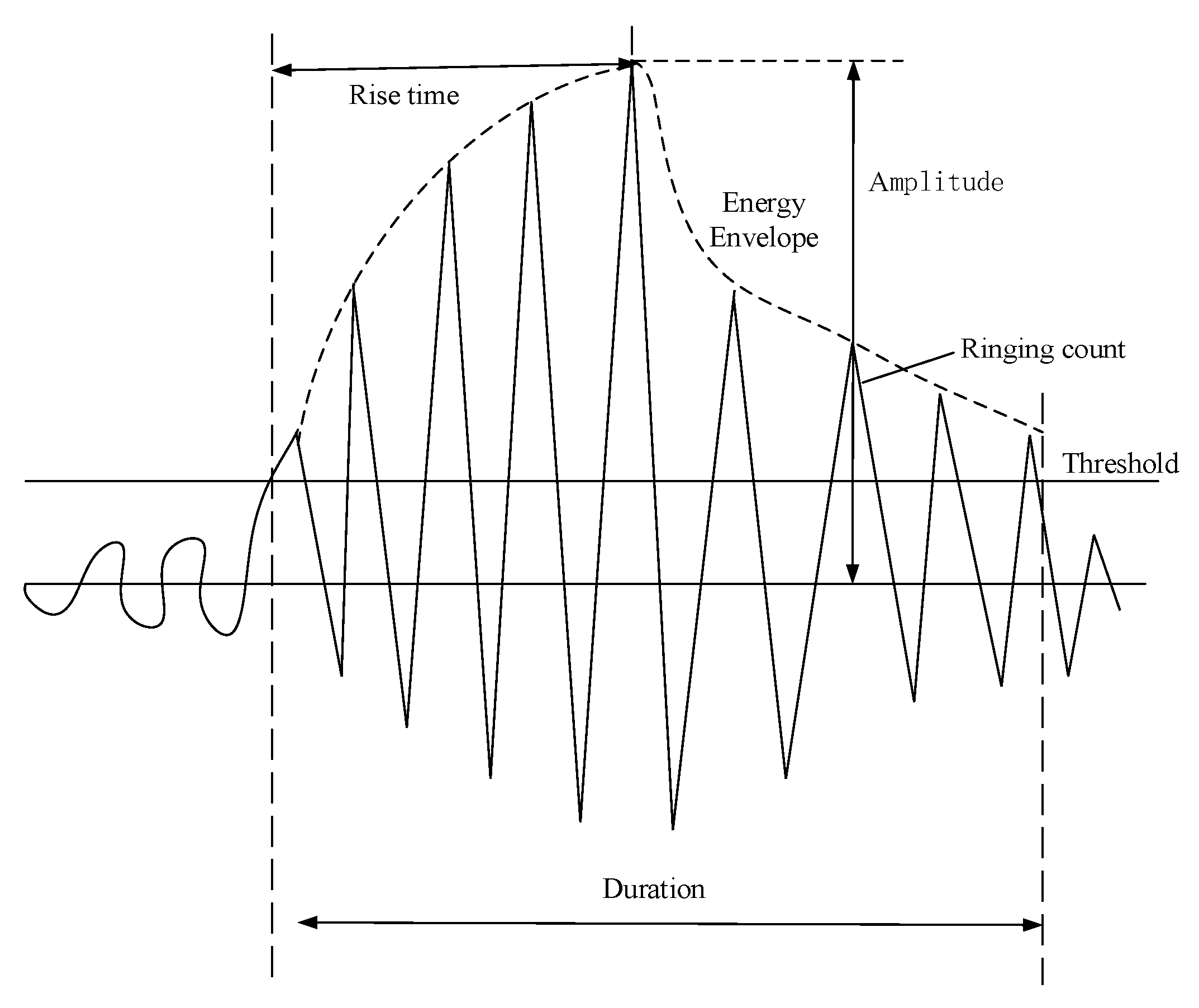
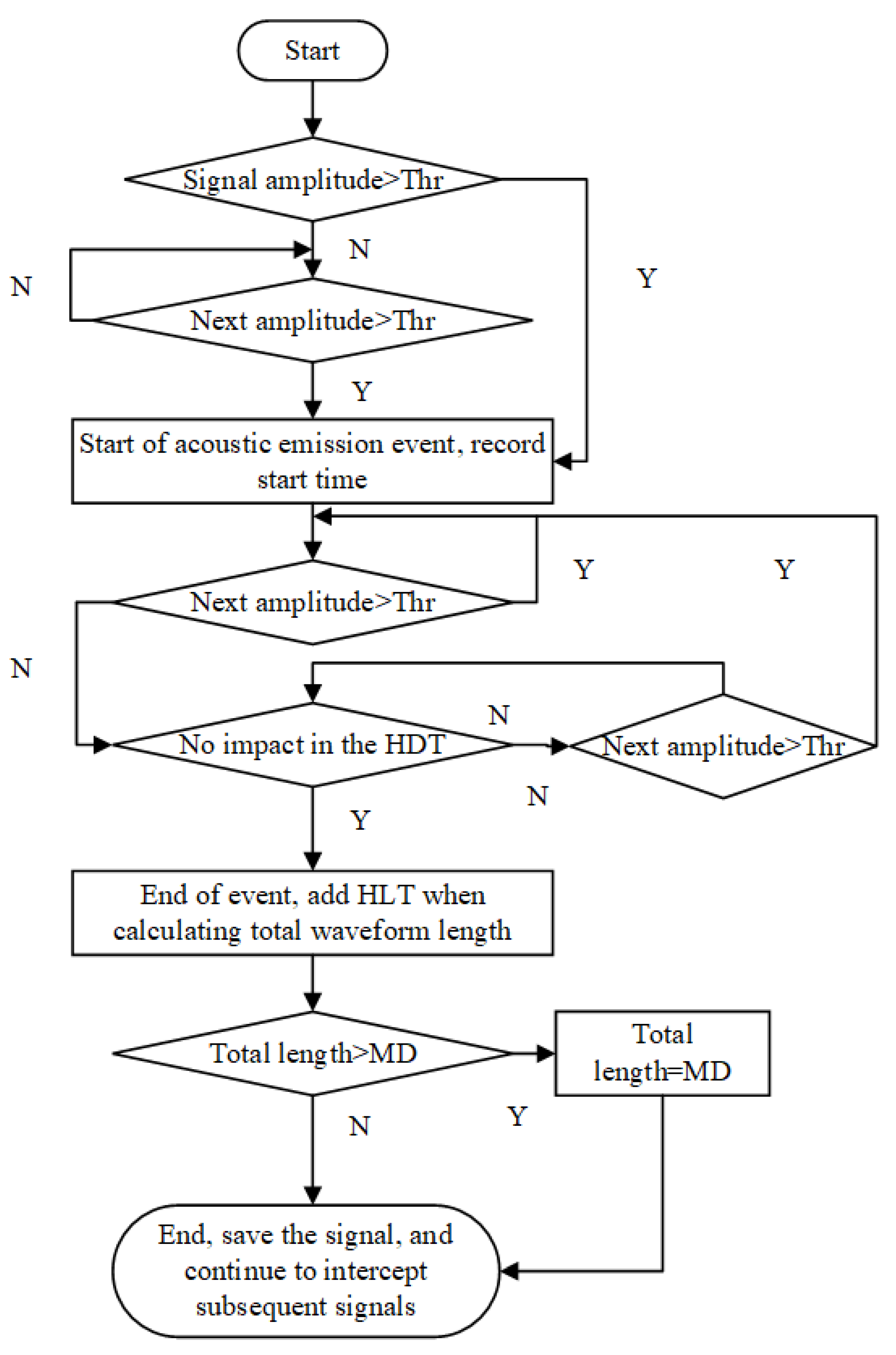
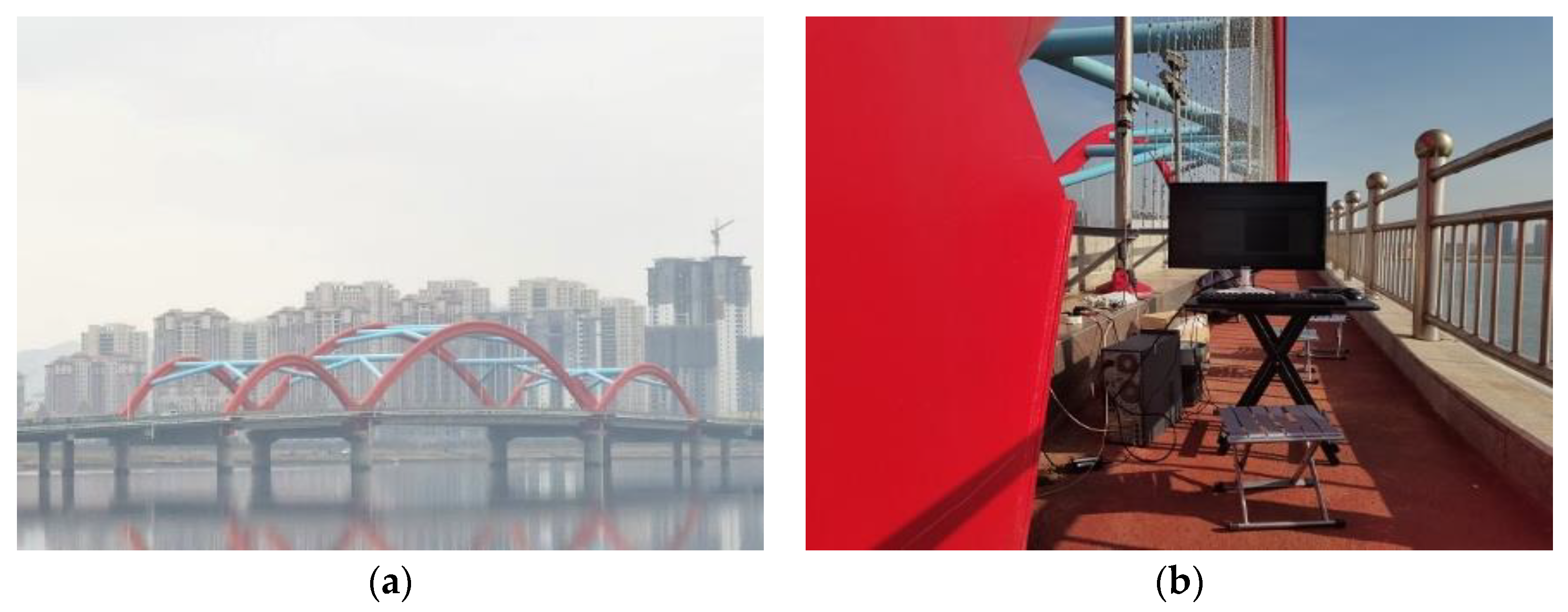

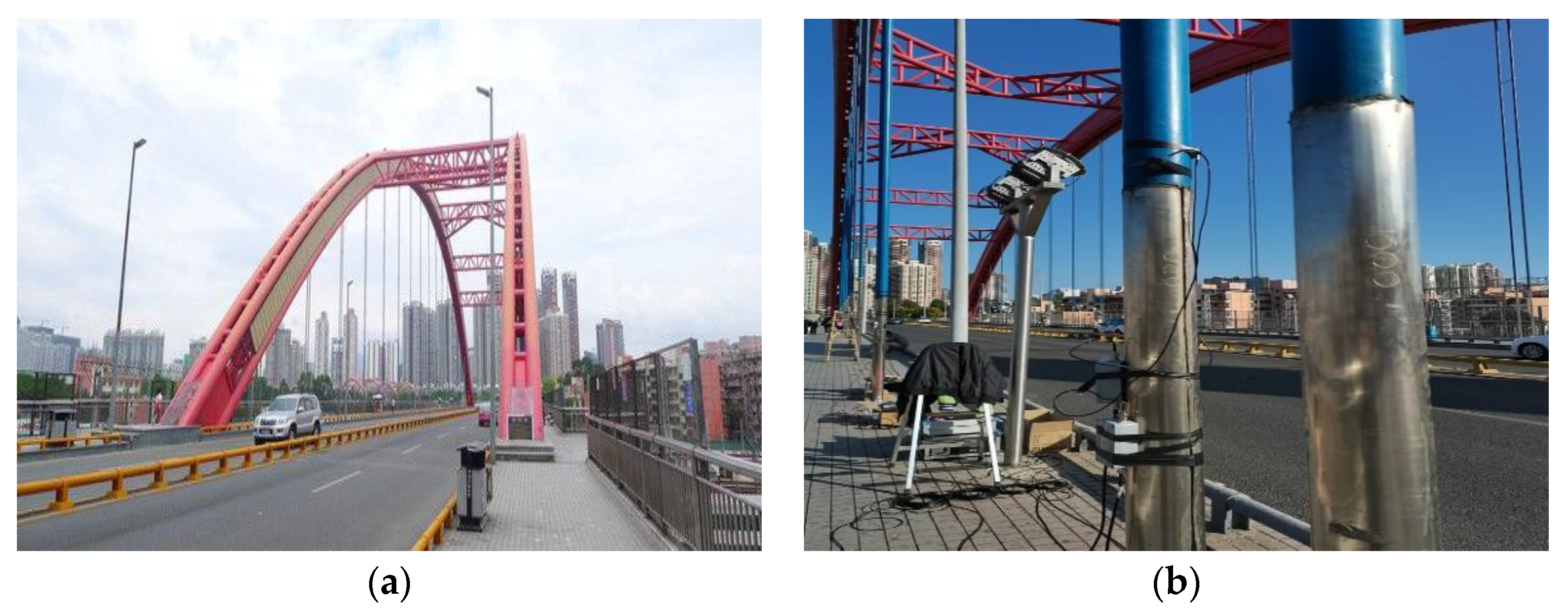
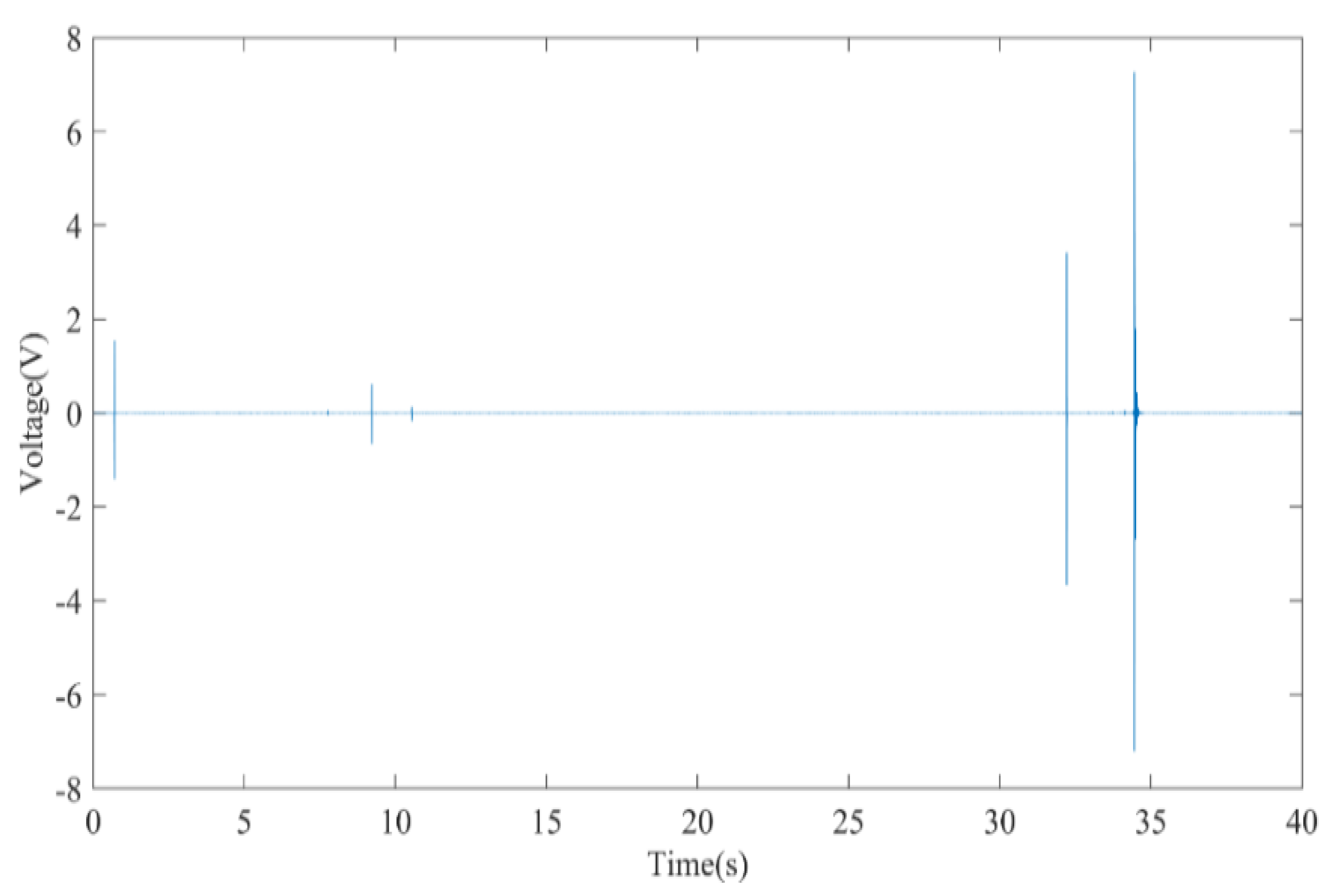
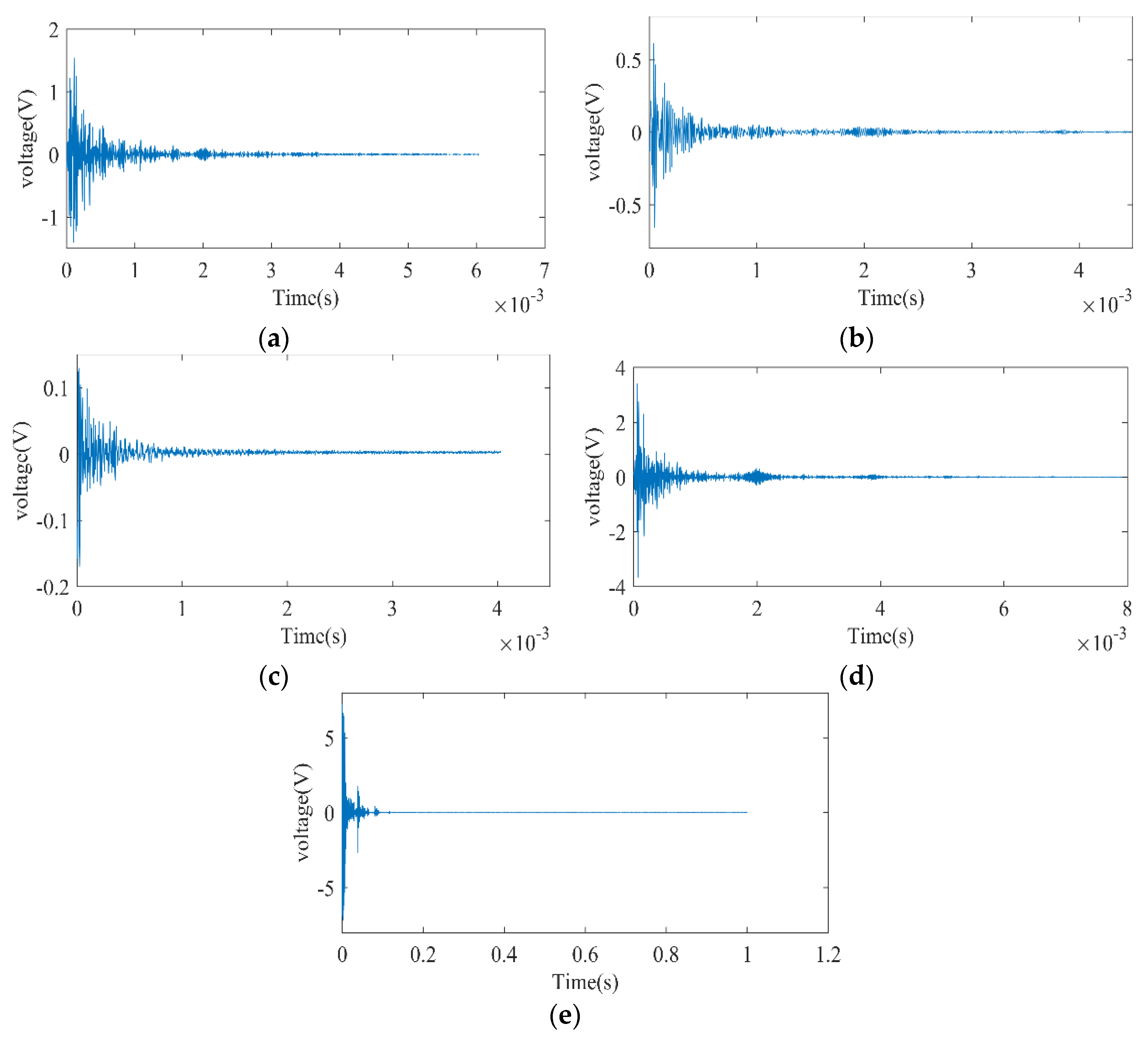
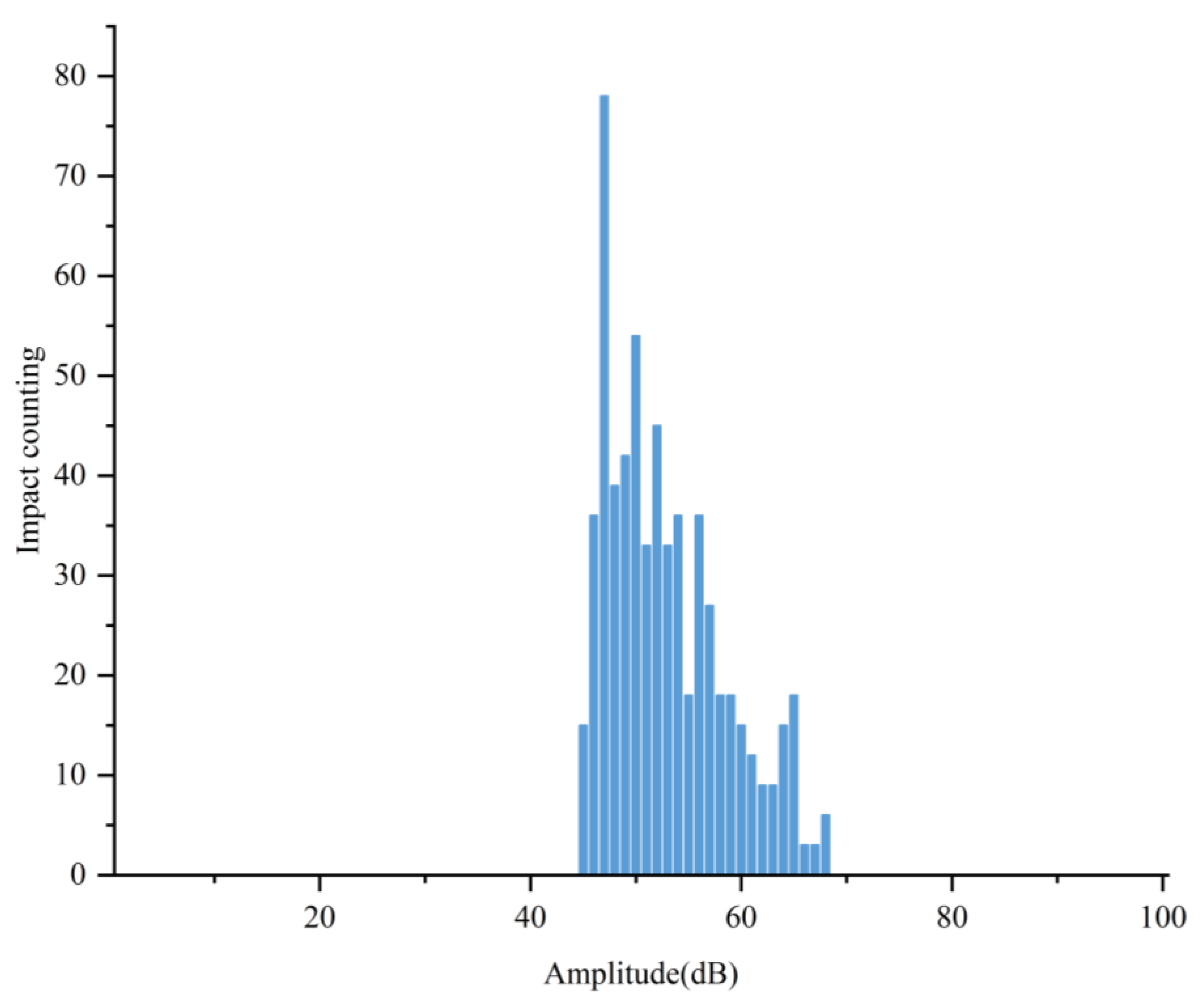
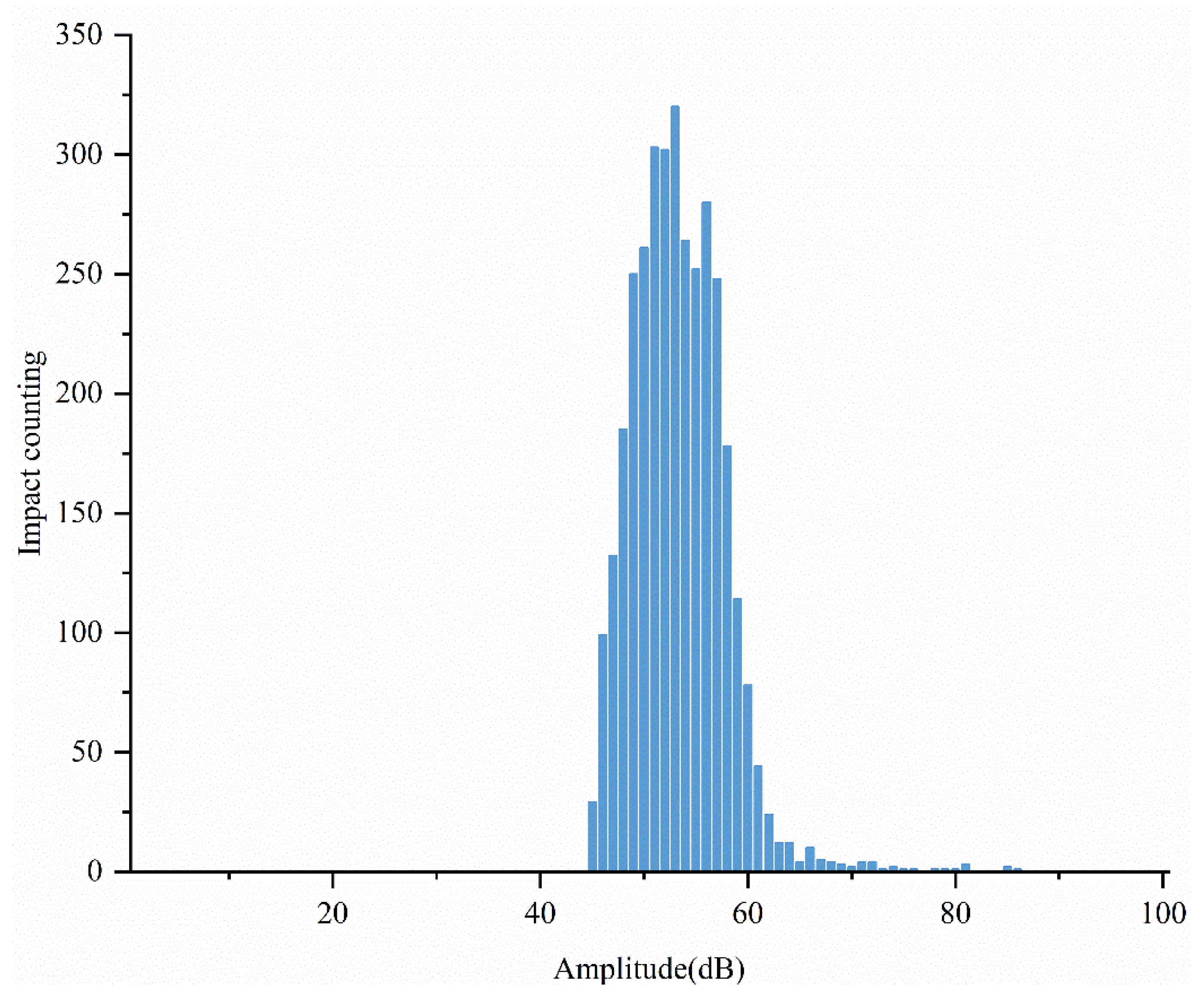

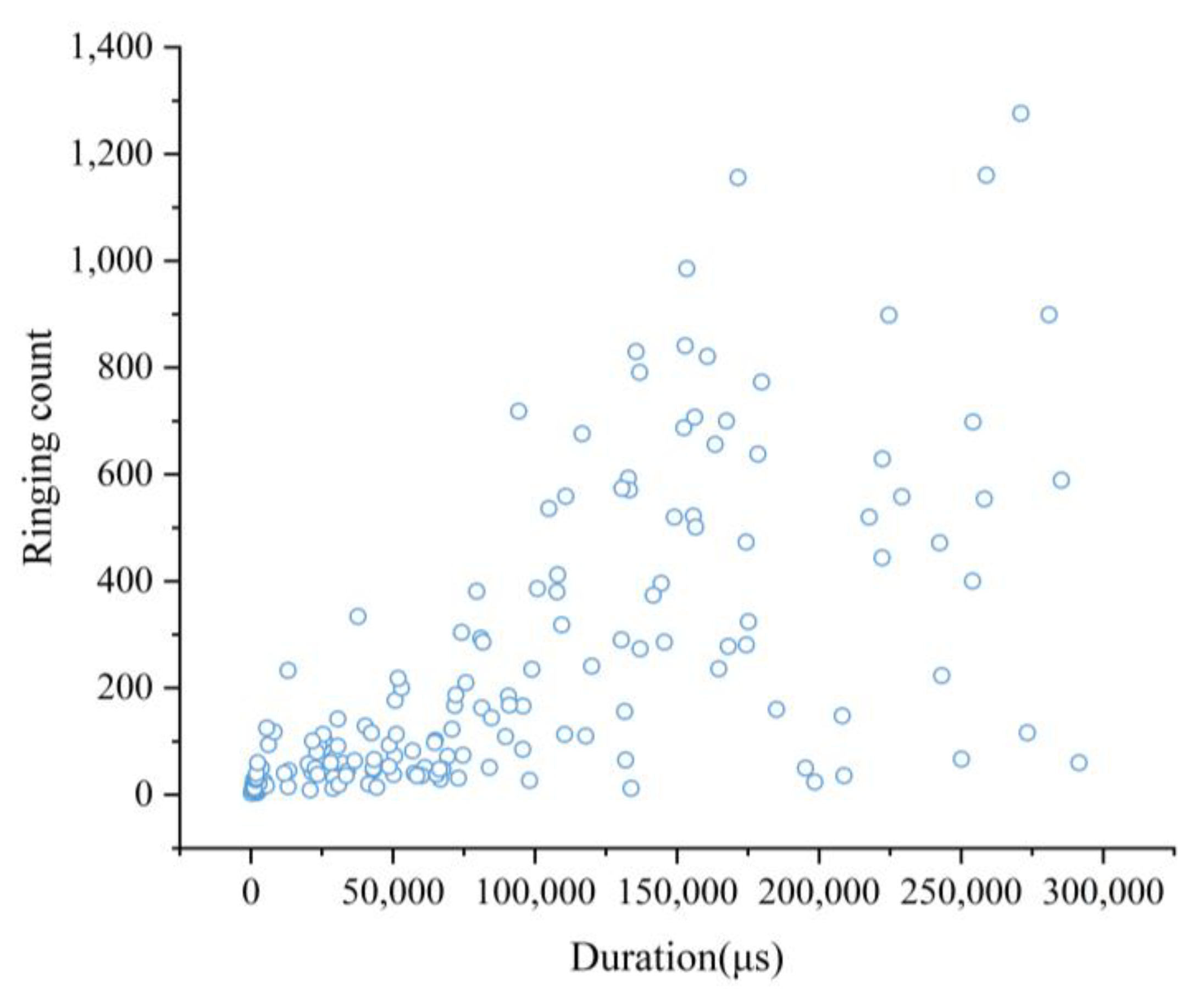
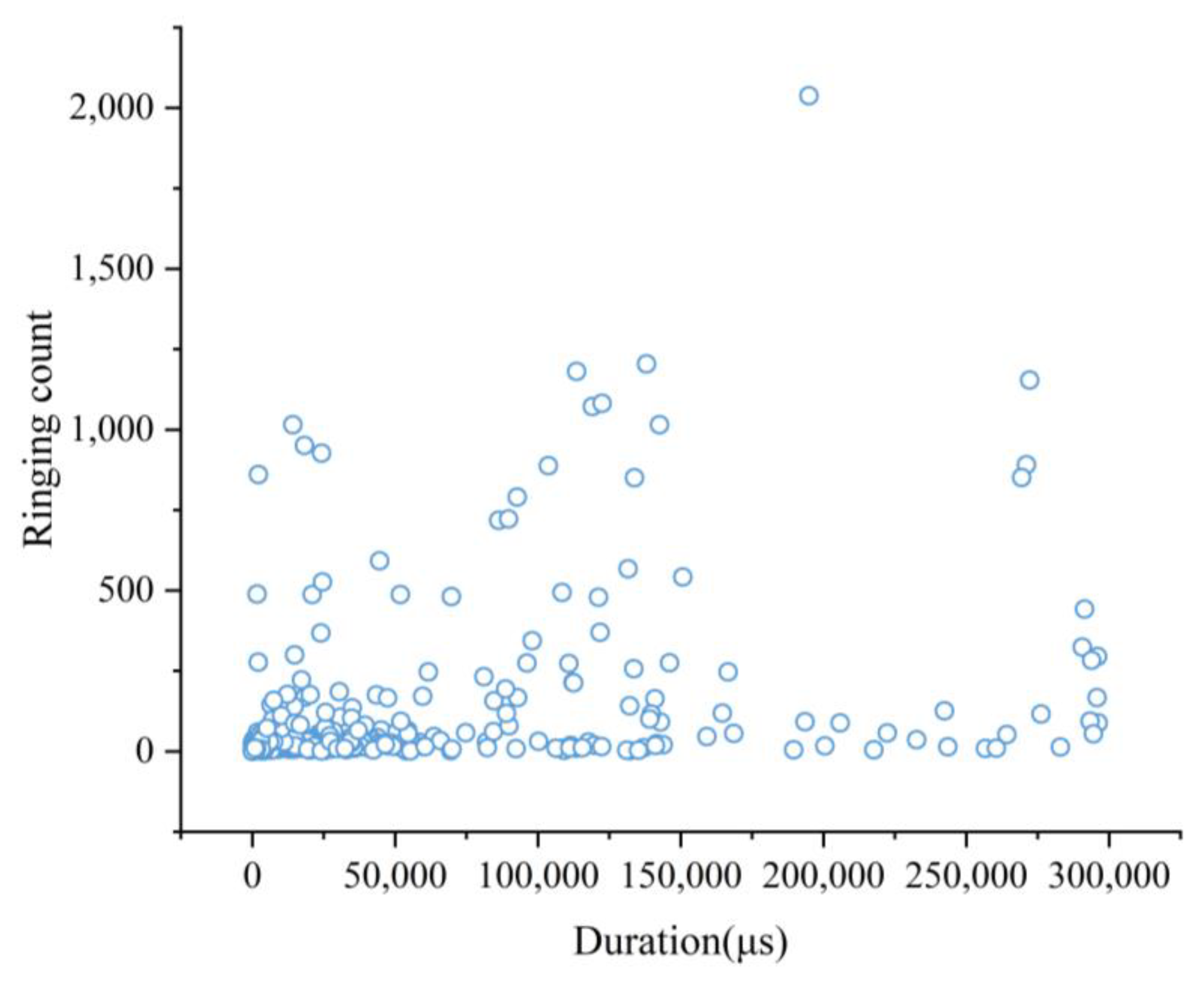
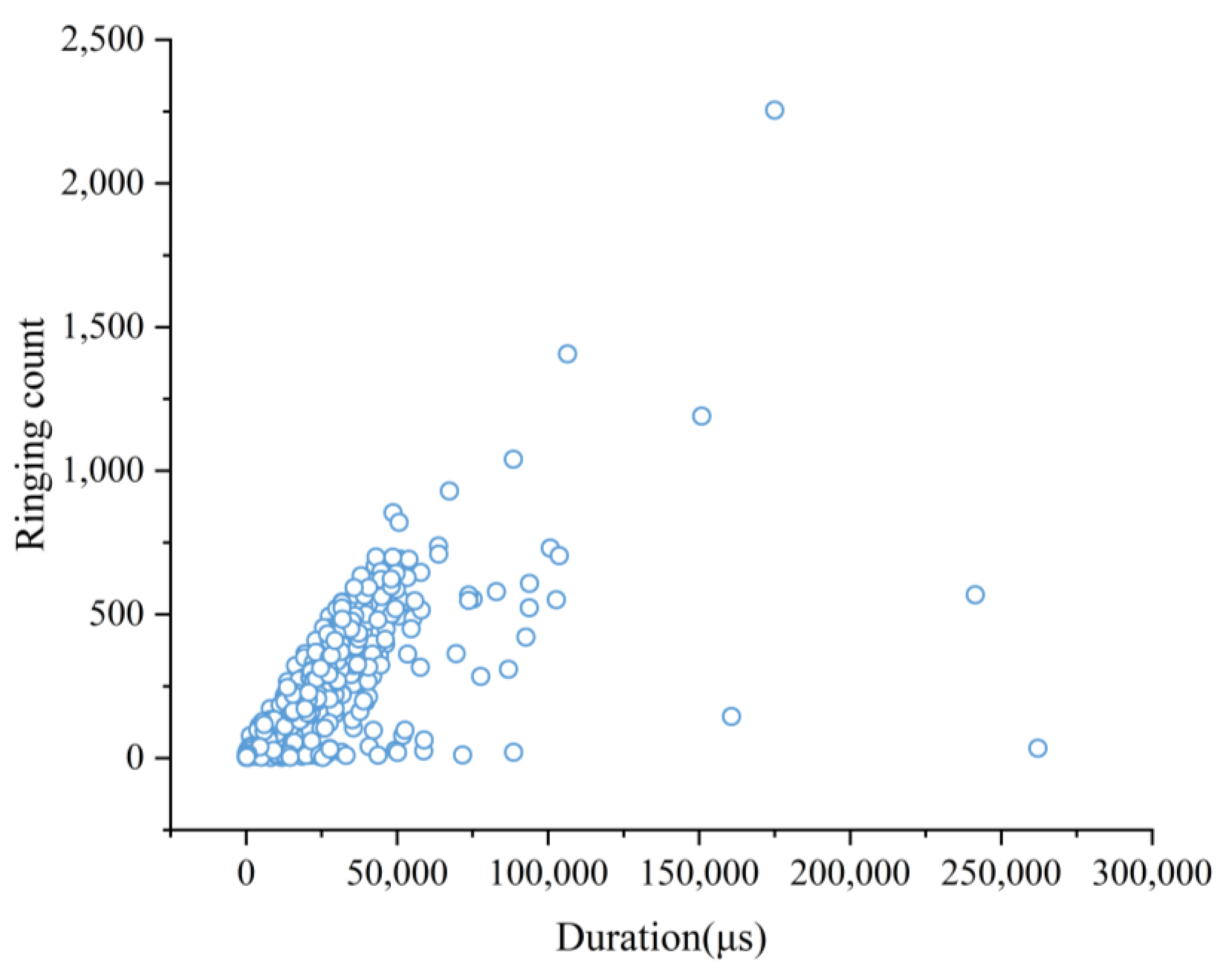
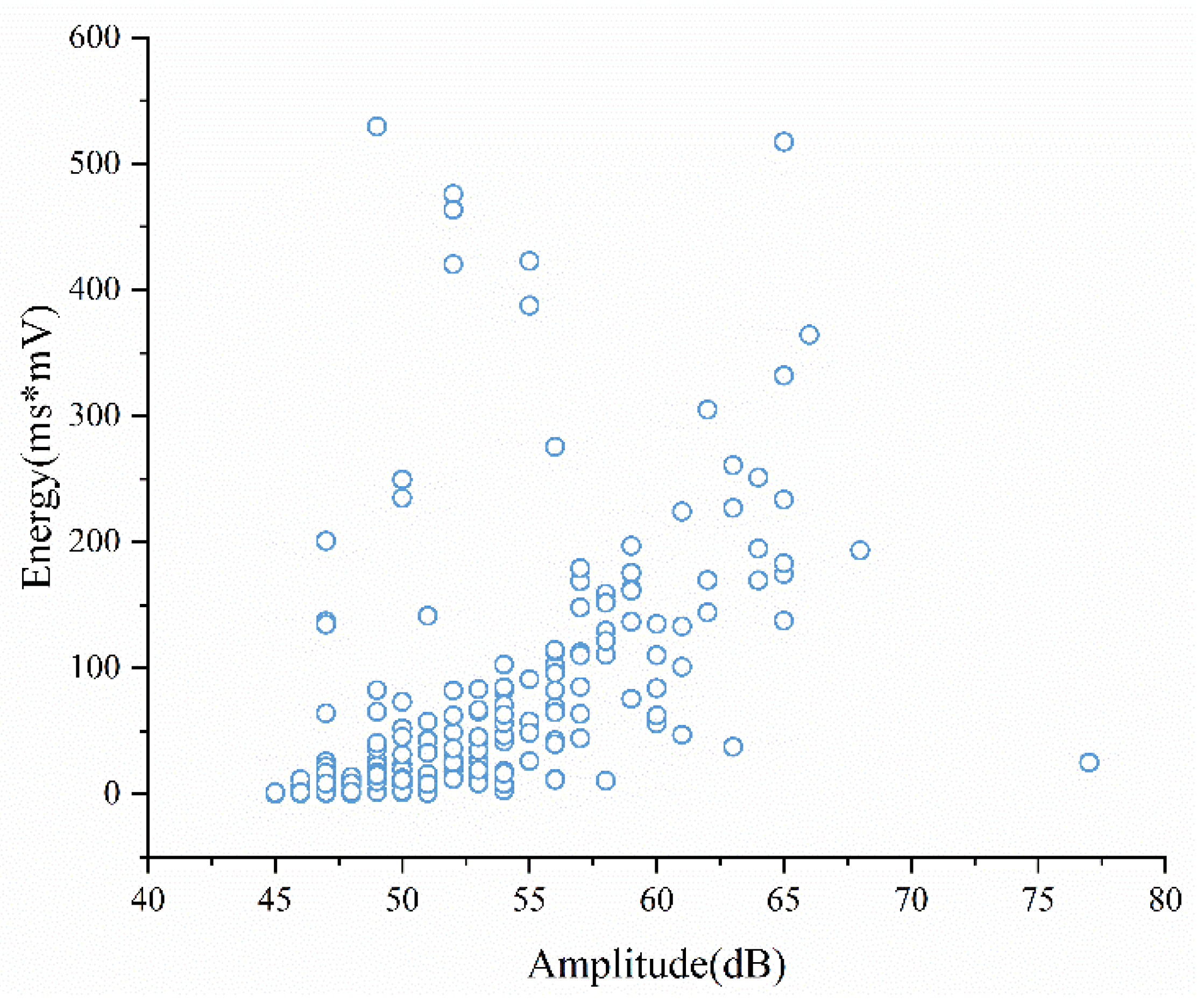

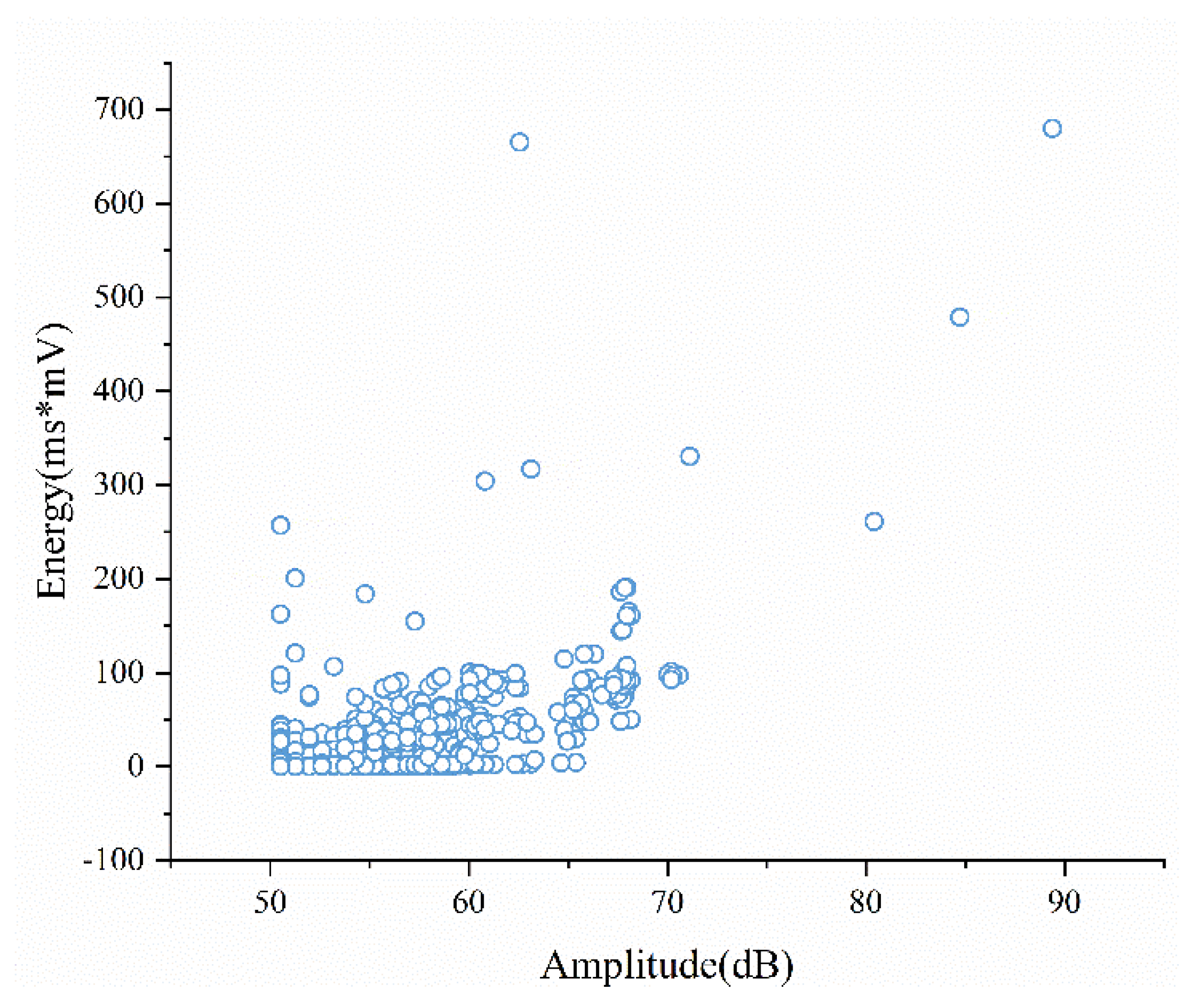
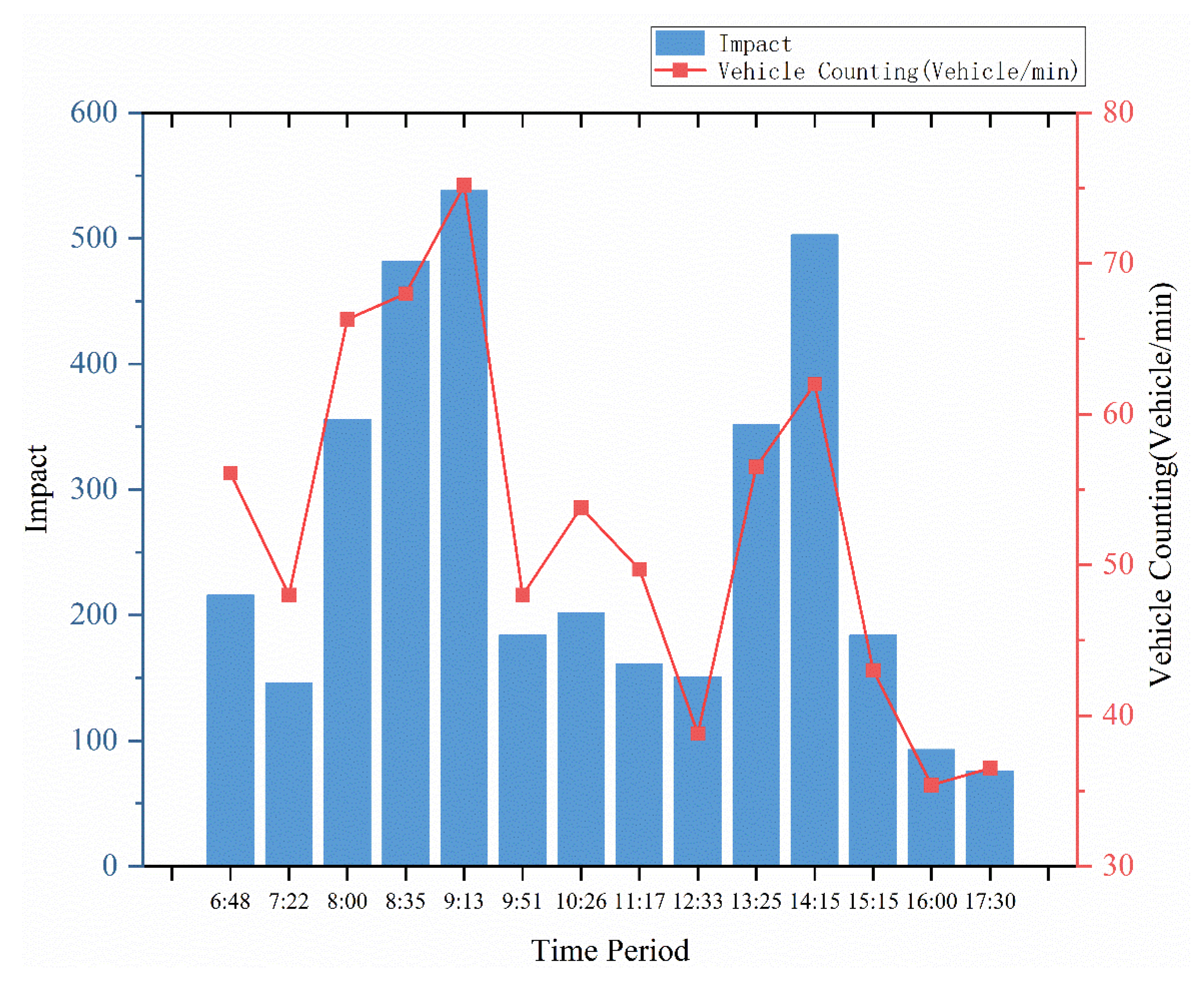
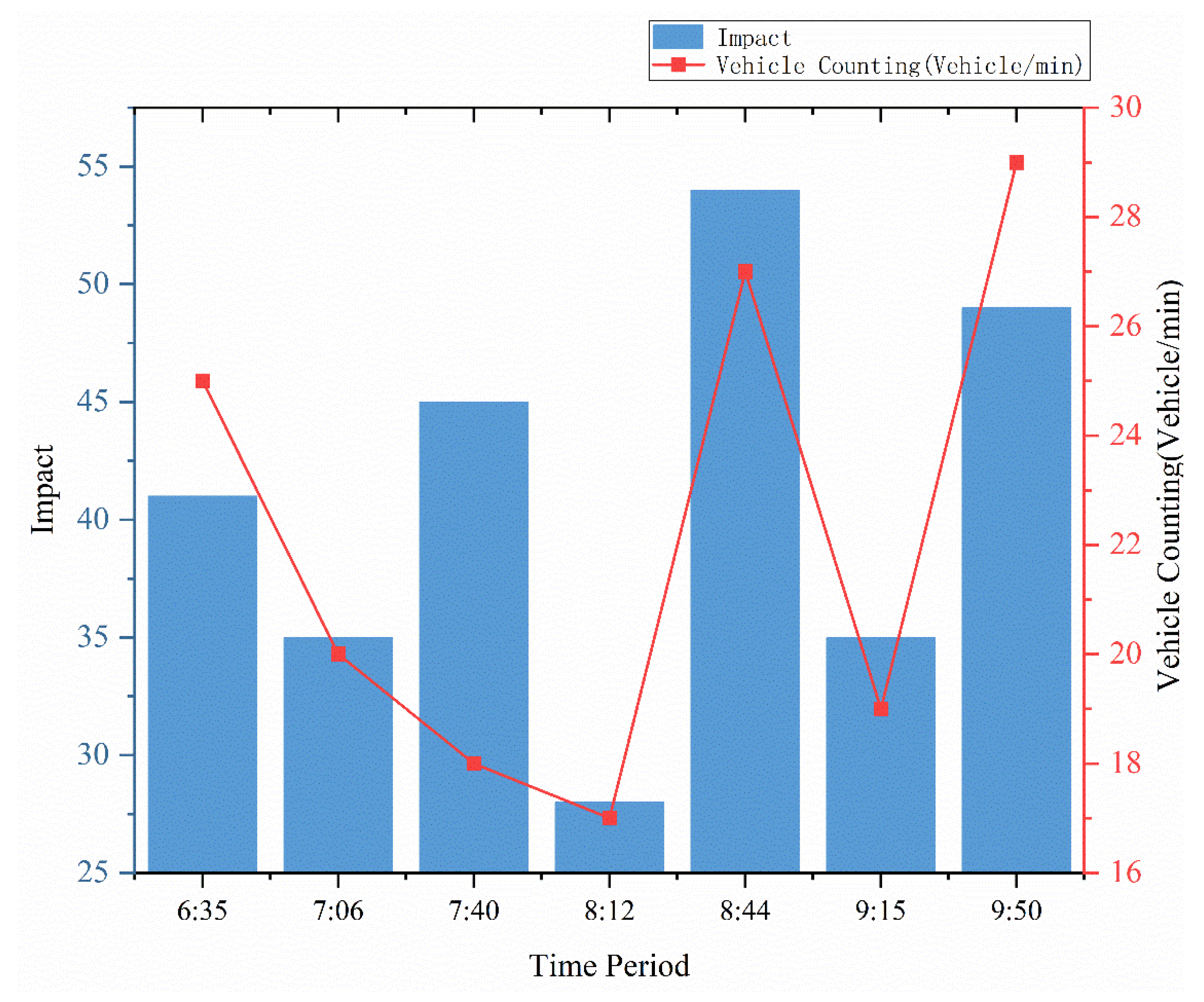
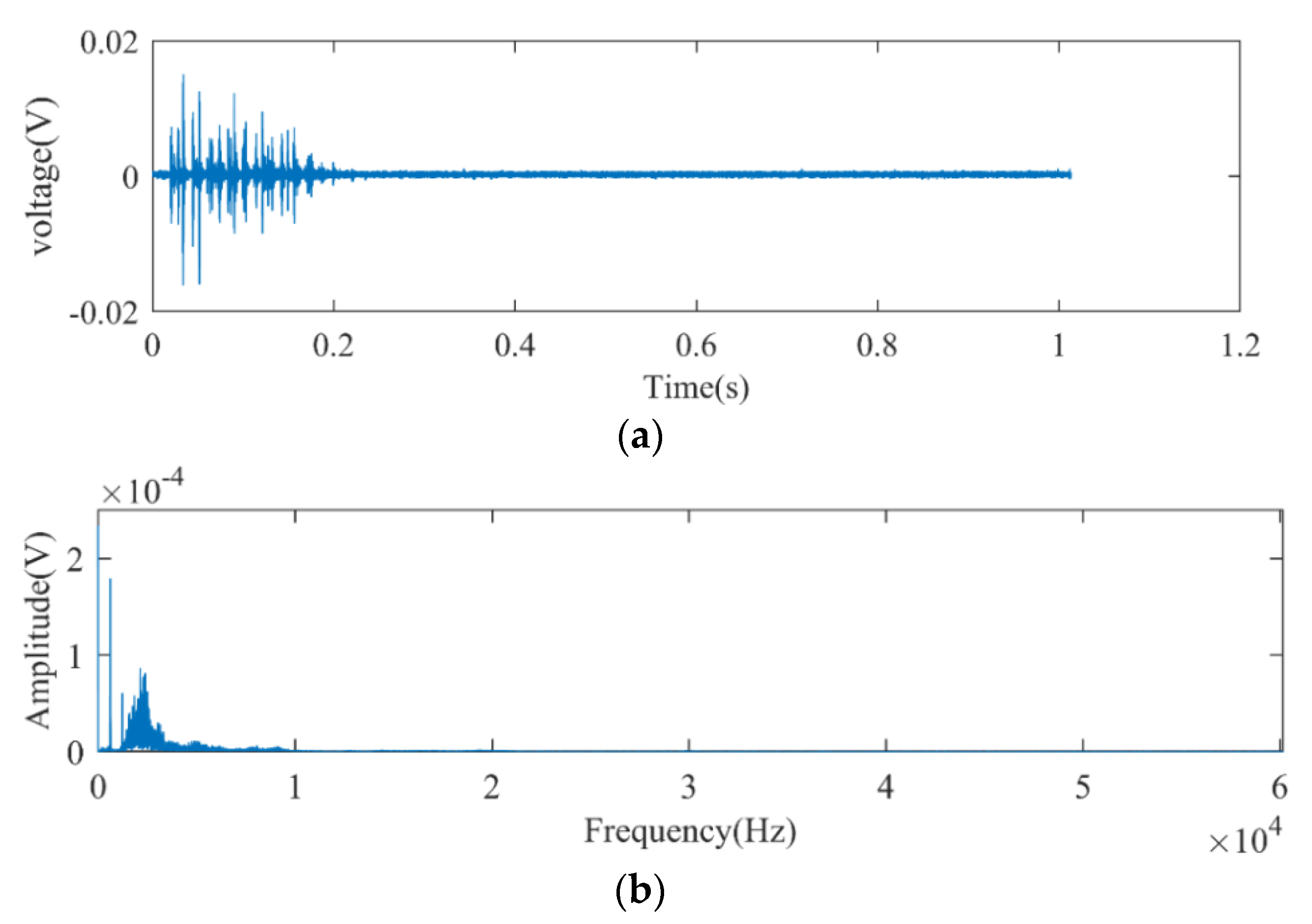

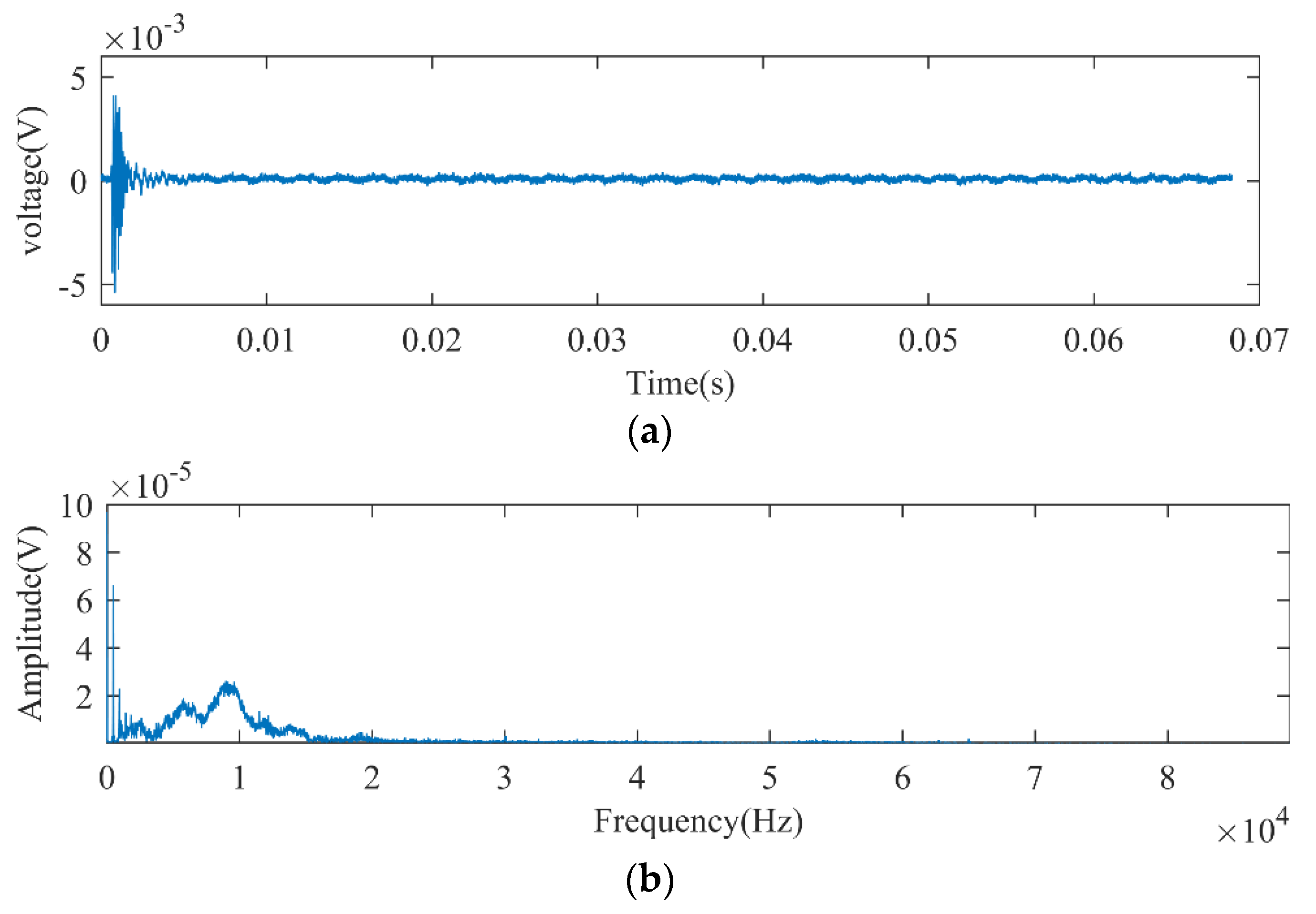
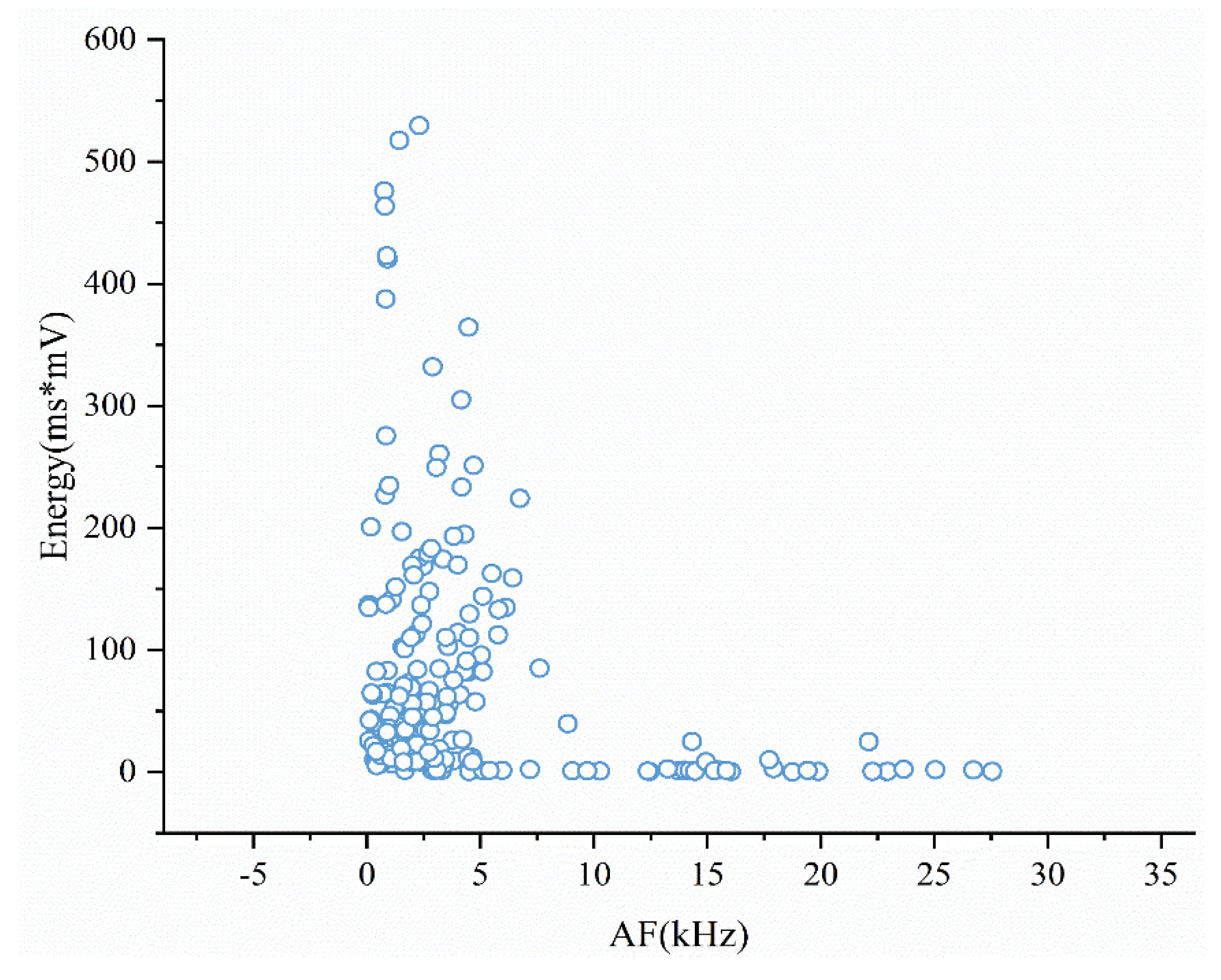

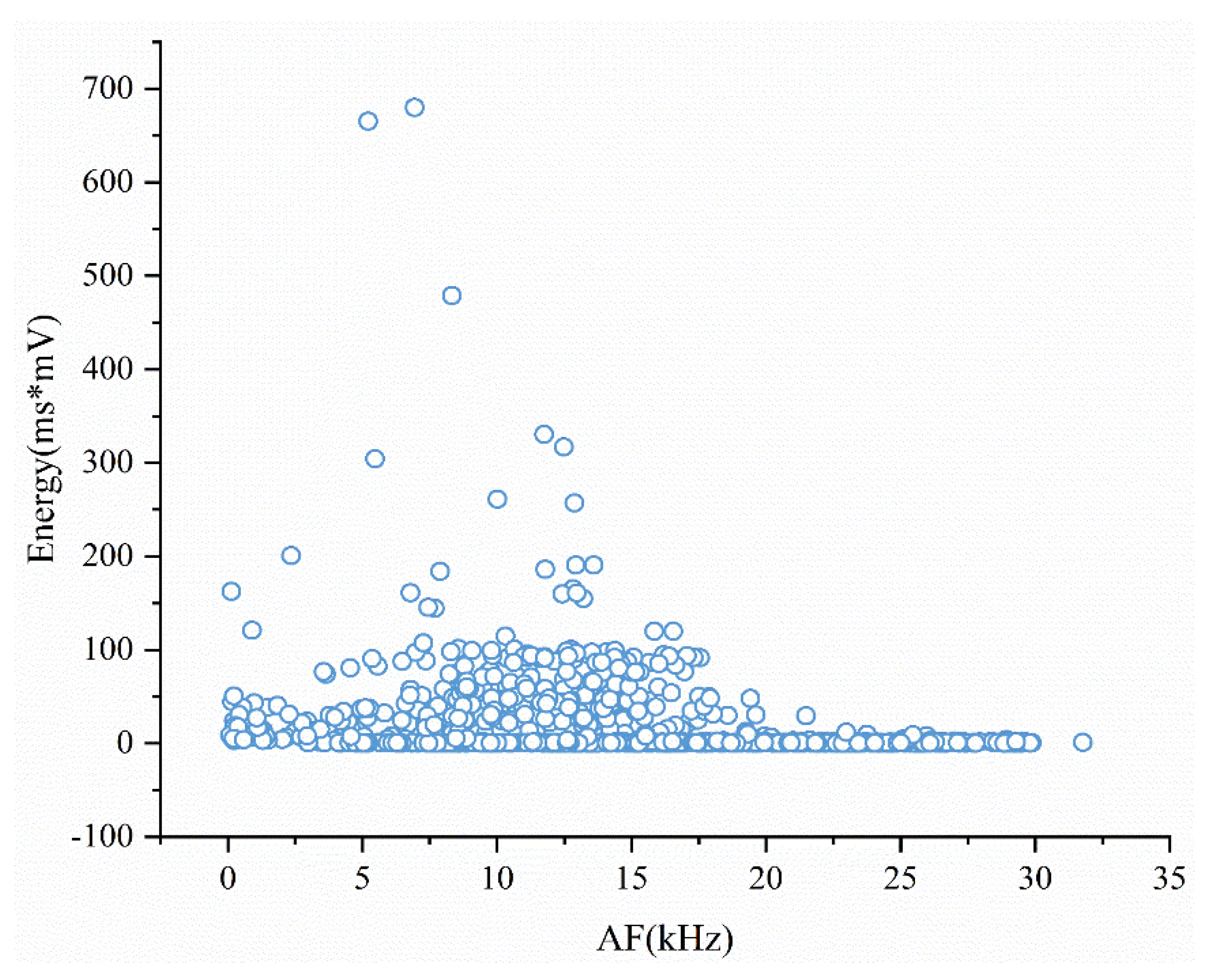


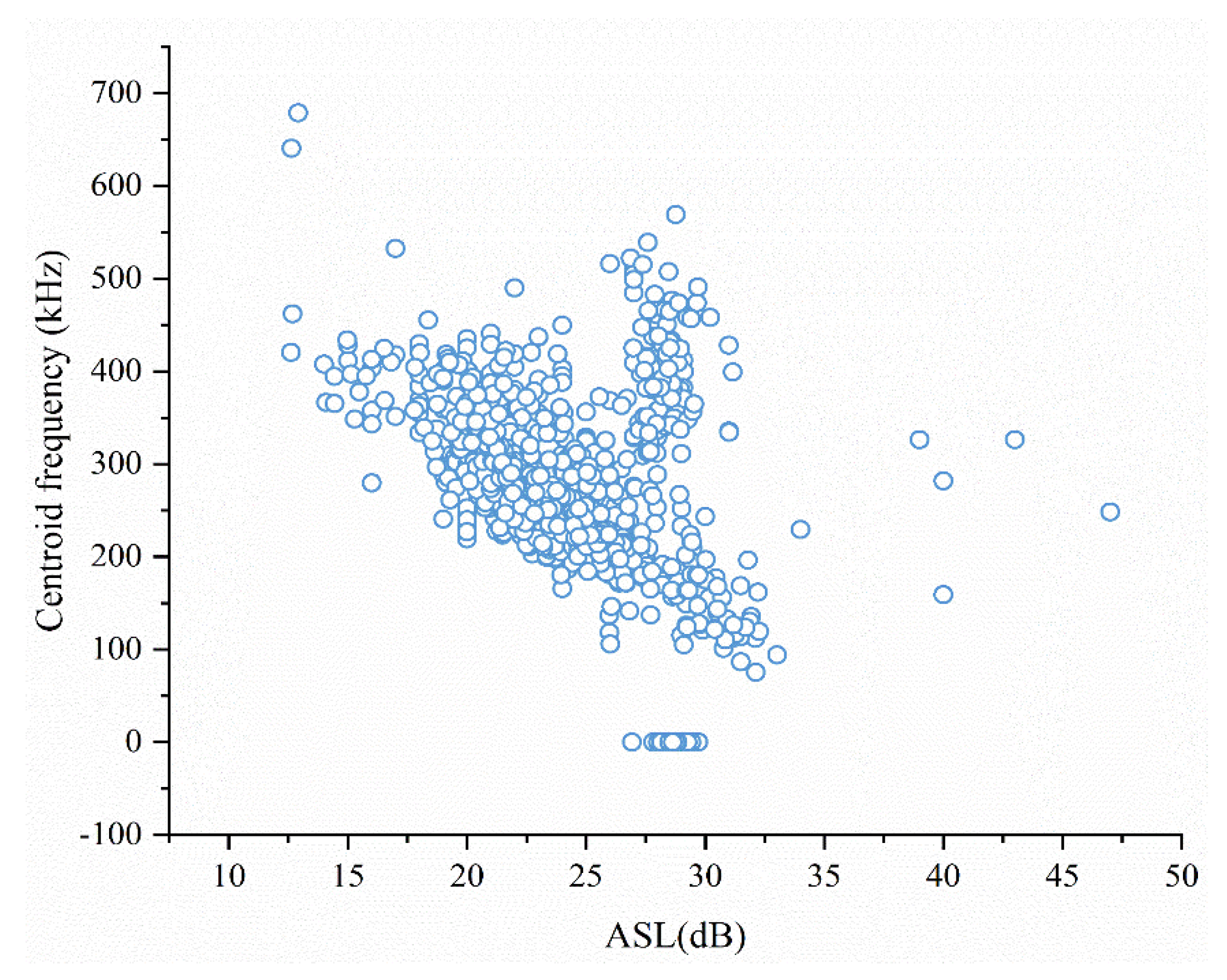
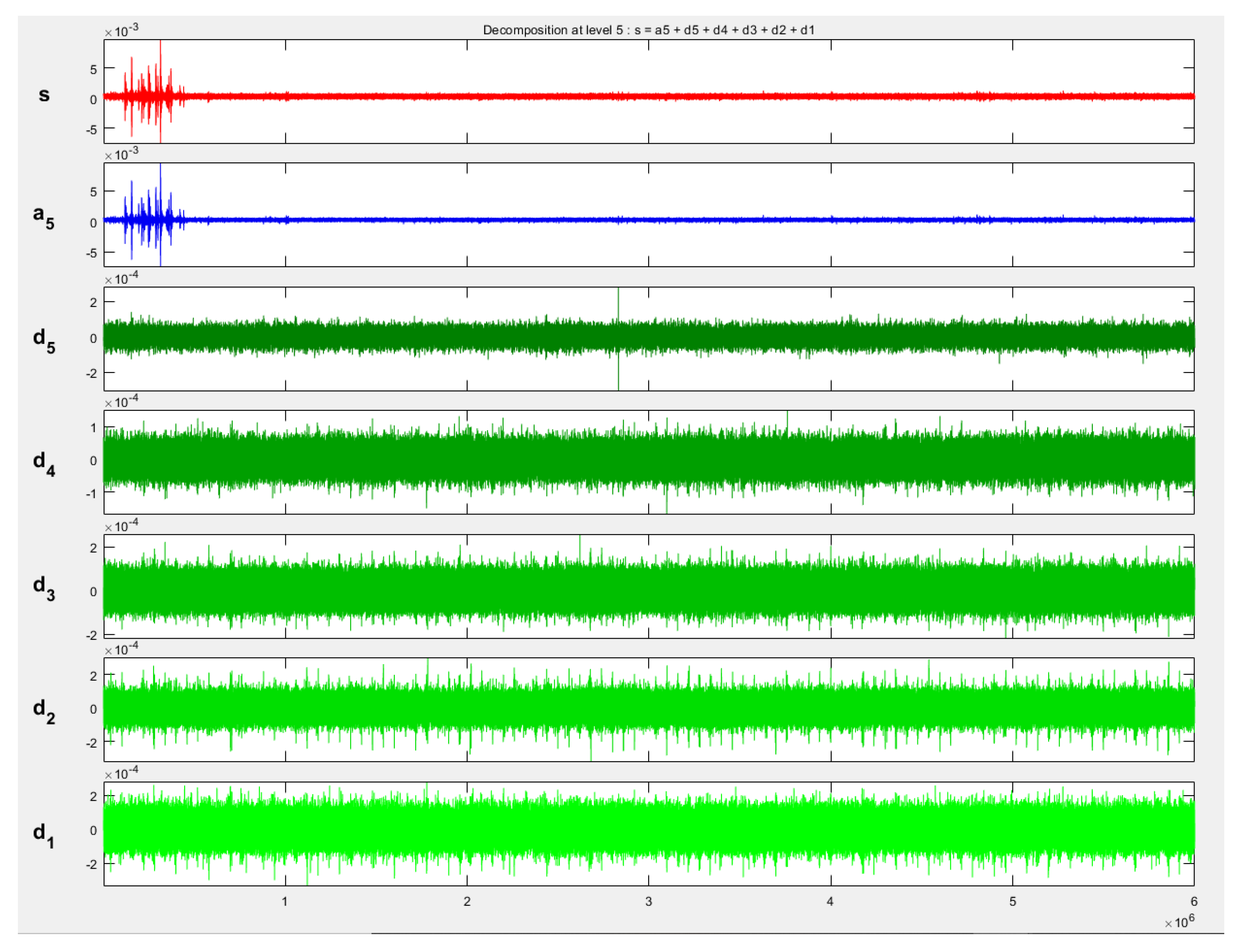

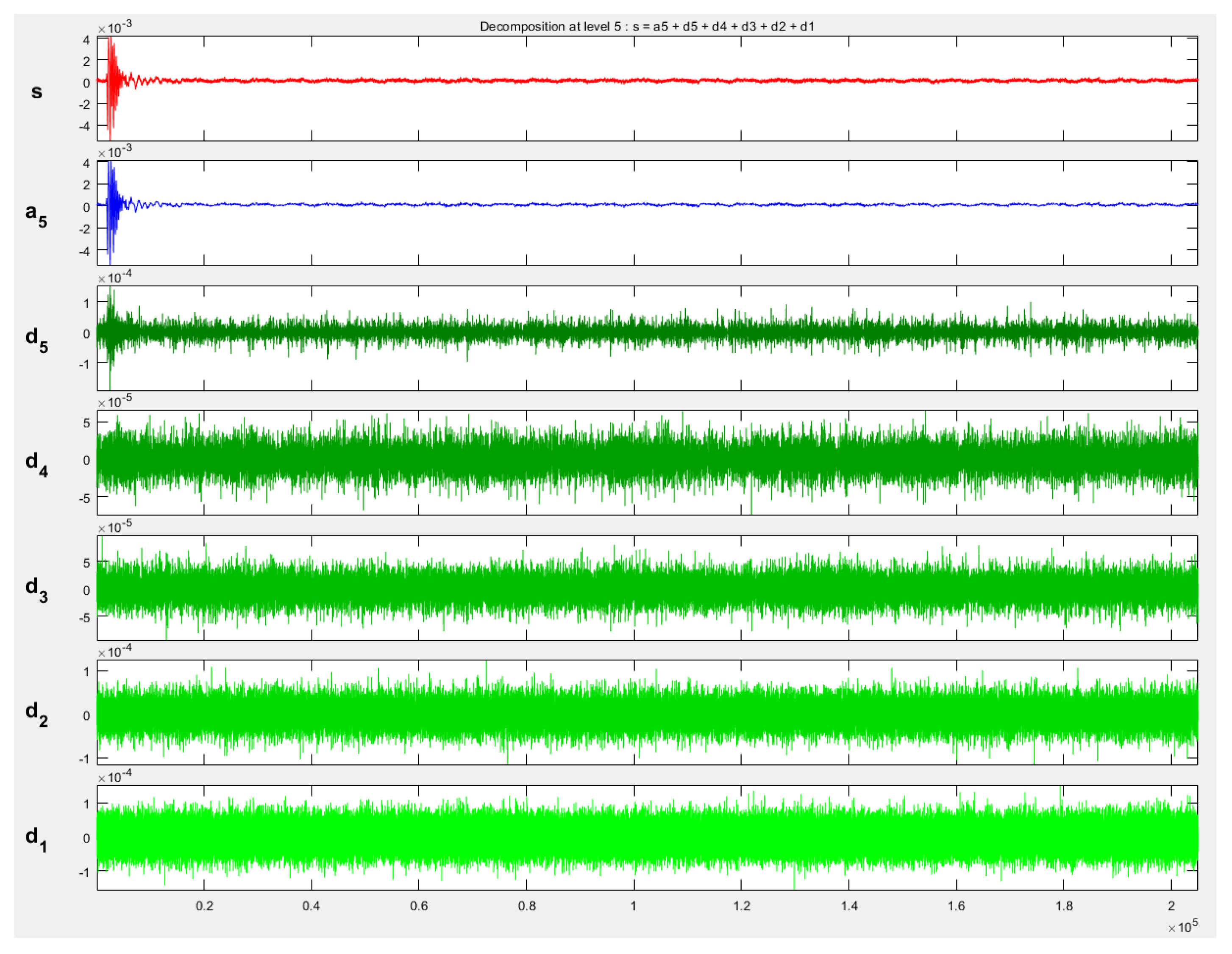
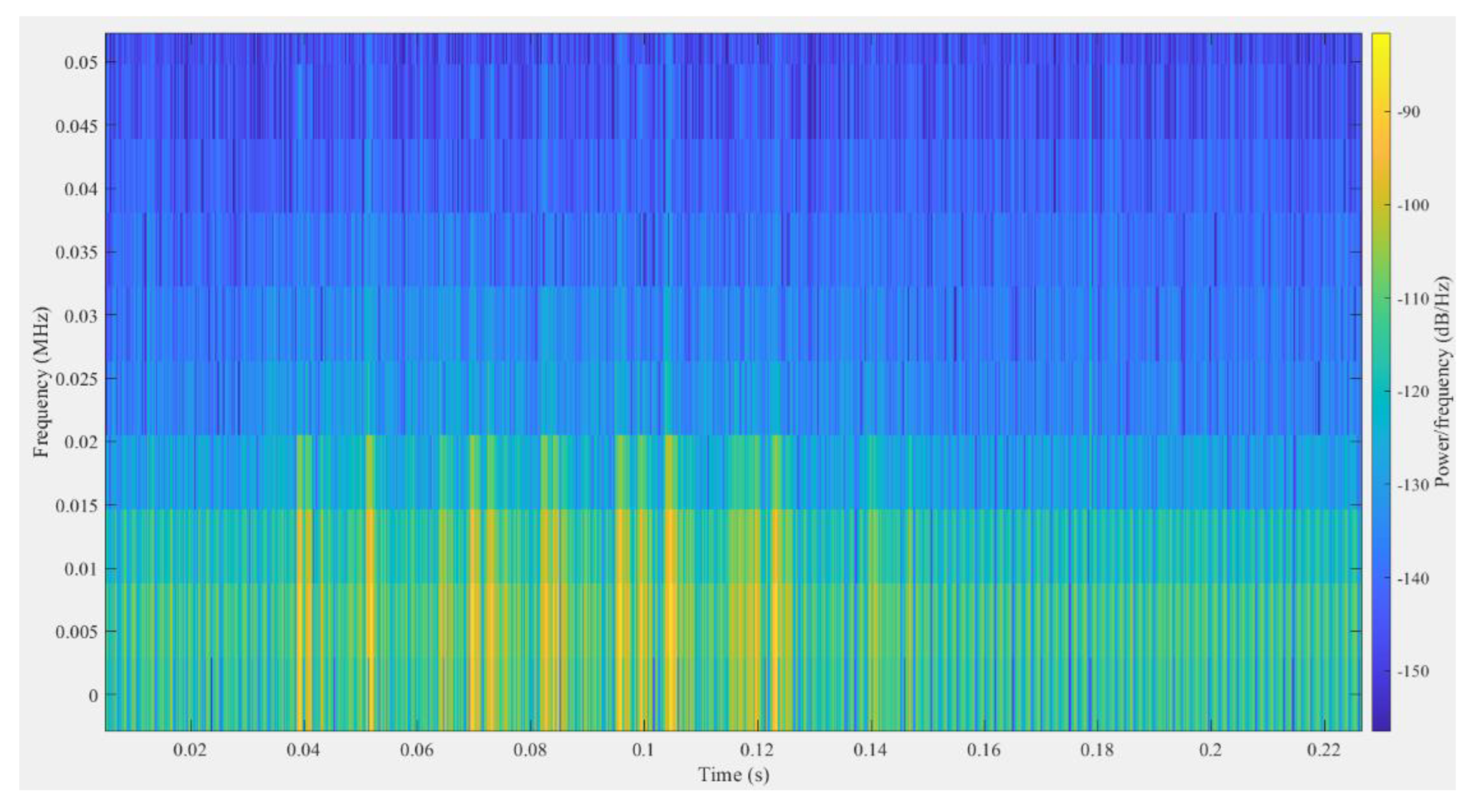
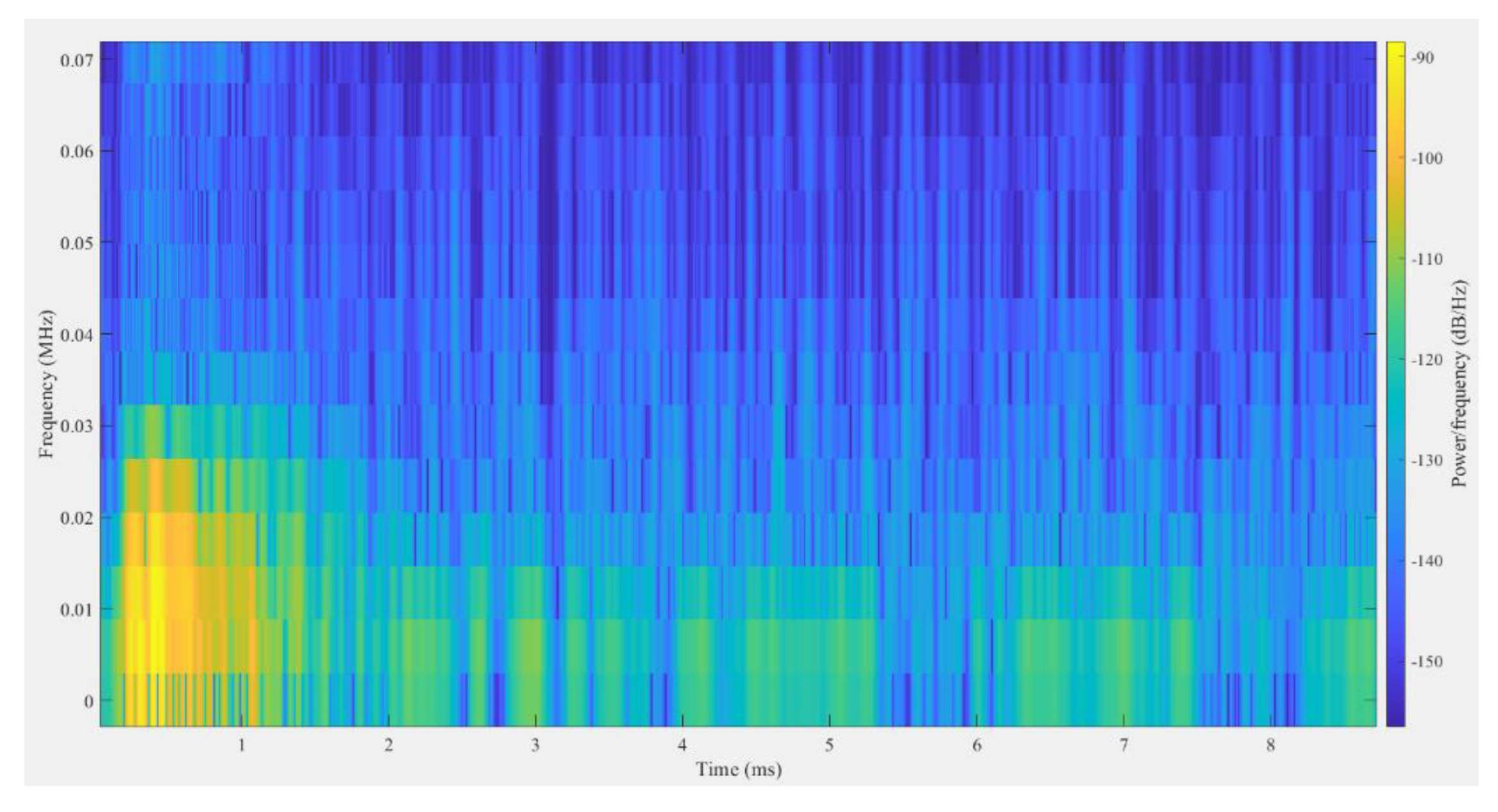
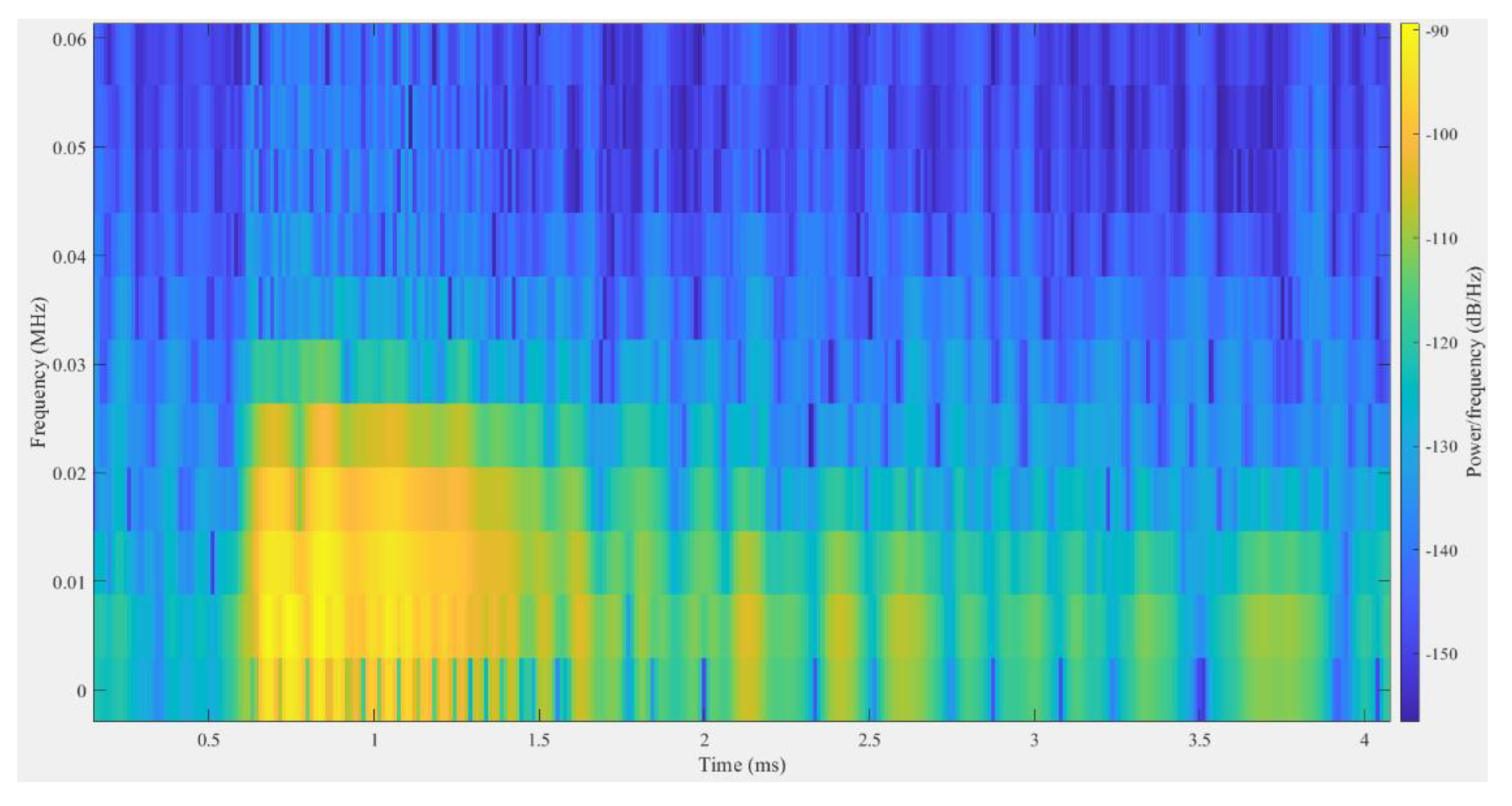
| Serial Number | Rise Time (µs) | Duration (µs) | Ringing Count | Amplitude (dB) | Energy (ms*mV) | AF (kHz) | ASL dB |
|---|---|---|---|---|---|---|---|
| 1 | 11,949 | 12,396 | 13 | 53 | 2.86 | 1.05 | 28 |
| 2 | 199 | 42,193 | 375 | 61 | 76.53 | 9.68 | 24 |
| 3 | 3977 | 46,368 | 449 | 62 | 90.60 | 10.87 | 25 |
| 4 | 1442 | 50,859 | 553 | 58 | 59.76 | 8.58 | 22 |
| 5 | 1425 | 46,252 | 397 | 59 | 58.15 | 8.02 | 23 |
| 6 | 628 | 44,164 | 354 | 60 | 62.19 | 13.58 | 24 |
| 7 | 151 | 38,947 | 529 | 62 | 91.63 | 12.43 | 26 |
| 8 | 3514 | 48,656 | 605 | 62 | 91.85 | 14.43 | 26 |
| 9 | 5220 | 44,630 | 644 | 60 | 100.40 | 12.75 | 26 |
| 10 | 1228 | 48,475 | 618 | 61 | 76.53 | 15.64 | 26 |
| 11 | 4376 | 13,906 | 42 | 54 | 11.91 | 3.02 | 19 |
| …… | |||||||
| 90 | 967 | 17,304 | 222 | 53 | 23.01 | 13.59 | 39 |
| 91 | 633 | 834 | 20 | 49 | 27.49 | 15.92 | 27 |
| 92 | 4070 | 27,566 | 122 | 53 | 23.74 | 4.43 | 19 |
| 93 | 12,087 | 38,825 | 436 | 56 | 53.22 | 11.23 | 23 |
| 94 | 34 | 4632 | 33 | 52 | 4.97 | 7.12 | 21 |
| 95 | 2051 | 16,362 | 321 | 58 | 30.35 | 19.62 | 25 |
| 96 | 1537 | 12,592 | 171 | 58 | 22.20 | 13.58 | 25 |
| 97 | 2147 | 9154 | 85 | 53 | 10.77 | 9.29 | 22 |
| 98 | 4661 | 19,550 | 180 | 60 | 33.56 | 9.21 | 25 |
| 99 | 4048 | 13,517 | 178 | 54 | 20.40 | 13.17 | 20 |
| 100 | 3007 | 34,021 | 351 | 65 | 114.52 | 10.32 | 30 |
| Wavelet Decomposition Parameters | a5 | d5 | d4 | d3 | d2 | d1 |
|---|---|---|---|---|---|---|
| Energy Spectrum Coefficient | 98.17 | 0.20 | 0.19 | 0.48 | 0.38 | 0.59 |
| Wavelet Decomposition Parameters | a5 | d5 | d4 | d3 | d2 | d1 |
|---|---|---|---|---|---|---|
| Energy Spectrum Coefficient | 98.72 | 0.18 | 0.01 | 0.12 | 0.23 | 0.68 |
| Wavelet Decomposition Parameters | a5 | d5 | d4 | d3 | d2 | d1 |
|---|---|---|---|---|---|---|
| Energy Spectrum Coefficient | 97.89 | 0.28 | 0.15 | 0.22 | 0.41 | 1.05 |
Publisher’s Note: MDPI stays neutral with regard to jurisdictional claims in published maps and institutional affiliations. |
© 2022 by the authors. Licensee MDPI, Basel, Switzerland. This article is an open access article distributed under the terms and conditions of the Creative Commons Attribution (CC BY) license (https://creativecommons.org/licenses/by/4.0/).
Share and Cite
Li, G.; Zhao, Z.; Li, Y.; Li, C.-Y.; Lee, C.-C. Preprocessing Acoustic Emission Signal of Broken Wires in Bridge Cables. Appl. Sci. 2022, 12, 6727. https://doi.org/10.3390/app12136727
Li G, Zhao Z, Li Y, Li C-Y, Lee C-C. Preprocessing Acoustic Emission Signal of Broken Wires in Bridge Cables. Applied Sciences. 2022; 12(13):6727. https://doi.org/10.3390/app12136727
Chicago/Turabian StyleLi, Guangming, Zhen Zhao, Yaohan Li, Chun-Yin Li, and Chi-Chung Lee. 2022. "Preprocessing Acoustic Emission Signal of Broken Wires in Bridge Cables" Applied Sciences 12, no. 13: 6727. https://doi.org/10.3390/app12136727
APA StyleLi, G., Zhao, Z., Li, Y., Li, C.-Y., & Lee, C.-C. (2022). Preprocessing Acoustic Emission Signal of Broken Wires in Bridge Cables. Applied Sciences, 12(13), 6727. https://doi.org/10.3390/app12136727








